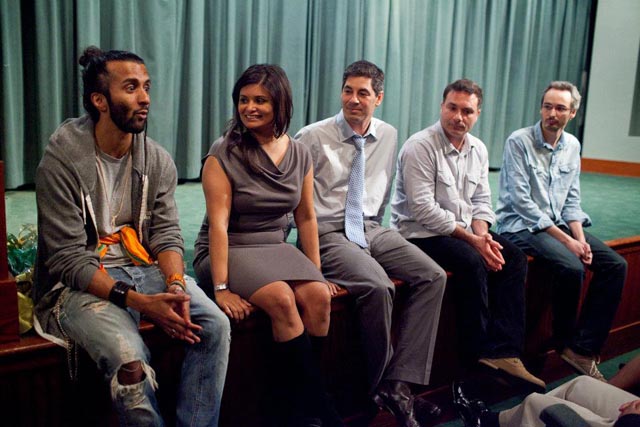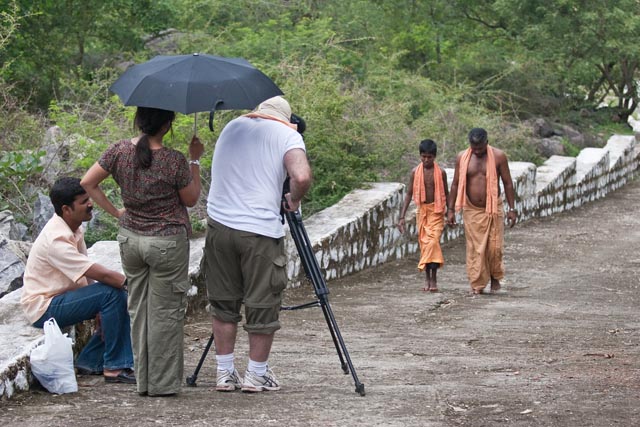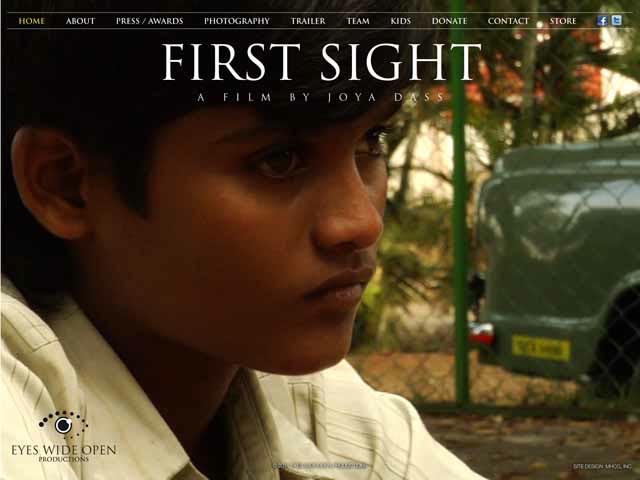
First Sight – From New York to Tamil Nadu
Joya Dass, financial reporter in New York, went to India and came back with a fresh perspective and outlook on life. It led her to tackle a new career – that of documentary film-maker. ‘First Sight’ is the documentary which resulted from that trip. Recently she had a first screening of her film and plans to take it on the festival circuit.
First Sight – A Look
11 Questions for Joya Dass, Director ‘First Sight’
1. What motivated you to make the film?
At 30, I was a financial reporter for CNN. Every day I would deliver the morning market preview on CNN International at 5 am New York Time. My grandmother would be watching a 1000 miles away at 5 pm Calcutta time. I’d call her to give her a heads up fifteen minutes before I was on air. In turn, she would call up the whole neighborhood to turn on their TV’s to watch. She was so proud…. Meanwhile, I had never met her before. My parents emigrated to the US in 1969 from India and, as many immigrants are want to do, never went back. After a year of this, I tired of our superficial exchanges over the phone. I bought a ticket and went to India by myself to meet her and my entire extended family for the very first time.
2. What were your reactions to India?
Anyone who has travelled home for the first time, has a number of adjectives to describe India: Overwhelming. Overpopulated. Exotic. Dirty. Inefficient. Loud. For me, the word was: Home. Thousands of miles from my pre-war brownstone on Central Park West, I felt an overwhelming sense of belonging.
I felt something big. I was one of those rare and precocious children who knew since the age of 11, that I had wanted to be a journalist. I had achieved it. By 2004, I appeared every morning on the oversized jumbotron in Times Square as the morning financial reporter on ABC. Reaching that success had taken so much personal sacrifice, willpower, and all out break from my traditional nuclear family to get there. All of it would have amounted to nothing, if I didn’t do something to give back . On my last visit to my grandmother’s house in Calcutta March 2009, the answer came to me. I could leverage the 15-odd years of television production skills to produce my first social justice documentary.
3. How did these plans materialize?
As the saying goes, be careful what you put out into the ether. The Universe has its own way of magnetizing it to you. .….Back home, safely entrenched in my life in New York, I was emceeing an AIDS India charity in May 2009. During my opening remarks, I mentioned my recent trip to India, and announced my desire to produce a documentary on a cause such as AIDS in India. Someone from the Sankara Eye Care Institutions, US, was at the event, and said, “I would love it if you did a documentary on our work!”
And so it goes. The idea congealed in May 2009. By December 2009, my then partner and I had assembled a team of 6 and headed off to Tamil Nadu, India to shoot “First Sight”
4. How did you get your New York team together?
Before touching ground, I had already decided that this film would be about children. Eye disease is an affliction commonly associated with the old. But, one fifth of the world’s blind children live in India. In my mind, it’s a demographic that still has their whole lives ahead of them. I needed a Director of Photography who was a master at artfully capturing children.
I remember being in a conference room in Dallas, sifting through the hundred-odd resumes that had flooded in from ad placed in Craig’s list. Resume reel number 3 was the winner. Marcelo Bukin, who had shot and directed many award-winning films (Dreaming Nicaragua), was originally from Argentina, but had spent time shooting films for foundations in Latin America.
His reel of a little cobbler boy named Joseu speaking about how his father beats his mother, got me. Marcelo had produced many of his films, so he also came on board as consulting producer while on the ground in India. This was a huge help, since ‘First Sight’ was my first documentary. The rest of the team was a friend, an editor I worked with at my job, my cousin’s husband who was Tamil, and was an excellent translator, given his time spent in Chicago. And my then real life partner.

5. What were the difficulties of trying to make the film, such as financing?
Man, if I never ask somebody for money or a donation again, I will be a happy girl! All of the $262,000 that went into making this film came from a series of fundraisers with friends and family in attendance. Beer was sponsored by a distributor of Indian beer. Food was sponsored by a local Indian restaurant. Silent auctions were comprised of donated Lasik surgeries, vacations to sustainable resorts in Mexico, Botox…..
Eventually, I had enough of a film edited, that I hit the road and hosted screenings across the country with prominent members of Indian society or prominent eye surgeons. Then asked folks from their networks to please donate money. It was a lot of knocking on doors. A lot of asking. A lot of rejection. But for every 13 rejections, there was one overwhelming YES! And when the YES came, it was the sweetest thing on earth.
6. What was the biggest high?
One of the biggest highs was listening to the music that Sivamani, who is a regular performer with Oscar winning composer AR Rahman, had composed for the film. Or Falu’s “alaap” for the trailer….. the music had a big orchestral, real feel sound that gave me goosebumps , when I thought about the mere shekels I had in my pocket to pay for it.
7. The biggest downer?
The biggest low was the break with my original producer and partner on the film. As most working relationships go, ours wasn’t strong enough to sustain the pressures of a big project like this. We split months into post-production.
8. Do you plan to take the film to the festival circuit or do you have a distributor for it?
I have entered the film into several film festivals and am in a silent period until the results are unveiled. I had my big New York Unveiling to thank Friends and family at the Tribeca Screening Room on March 22nd. Almost a 100 people showed up. I’m hosting a series of screenings in India, Japan, and Ireland later this year. The plan is to find a TV distributor.
9.What was the most memorable part of the filming, for you?
The human spirit in Tamil Nadu is probably one of the most amazing. My crew and I often commented while shooting, that our subjects may live in one of the poorest states of India, but their spirits were the most generous and giving.
As a journalist in New York City, I’m used to attitude, being ignored, asking folks to sign waivers and releases, people complaining about being filmed. In the far reaches of Tamil Nadu, our subjects were so willing to accommodate us.
10. Share a story with us.
Sankara was such a well run machine that we were always taken care of, and able to focus on shooting a good film. Patient Anitha’s parents lived in a small, thatched roof hut, hundreds of miles from the hospital where she was operated on. They greeted our crew with coconuts, sliced in half, with straws for our crew, so we could fight the hot Tamil Nadu heat while shooting at their house.
Meanwhile, we had been invading their lives for several weeks, Any American household would have told us to go eff our selves long ago. But they were so patient. So loving. So without guile or agenda. It was just beautiful. It’s also a little sad, because I know that those moments filming, as hard as they were, in the blazing Tamilian sun, will probably never be recreated again.
11. How do you hope to have an impact on the life of Ranjith and kids like him?
My goal is to spur folks to go online or reach for their checkbooks after seeing the film, and to donate to Sankara Eye Care Institutions in India. They are operating on kids like Ranjith and Anitha completely for free. But getting these backwards kids to a hospital, in some cases, requires so much goading and pushing.
India is such a complacent culture in some ways. Many of the patients “just lived with” their eye diseases because they believed it was “God’s will.” But conditions such as glaucoma and cataracts are completely curable. Nobody, especially a child aged 14 o 15, should have to live with a condition like this for the rest of his or her life. If Sankara is successful in continuing to send its battalion of medics to the outer rural reaches of India every single weekend, and continues to do their service for free, for years to come, then I’ve reached my goal with this film.

About ‘First Sight’
Some 45 million people in Southeast Asia live with some visual impairment. Eighty-five percent of these conditions are curable with a simple surgery. Most people, living in western cultures, could go to a doctor and have a cataract removed immediately. We, as filmmakers discover, that many members of India’s rural populations don’t have the money, access or education, so many just “live with it.”
Amidst the ignorance and neglect, there is a beacon hope.
In 1977, a team of volunteer doctors started bringing the eyecare to village doorsteps. They travelled weekly to the most remote hamlets of India to set up eye camps to treat and diagnose patients. The folks who needed surgery got operated on. The folks who needed glasses got low-vision aids—all for free.
“First Sight” follows Ranjith, Anitha and Balaji as they journey from their villages to undergo life-changing eye sugeries. At 15-years-old, Ranjith is severely depressed. Cataracts are clouding his vision in both eyes. Anitha, 5, has a parasite growing in her left eye. It’s threatening both her eyesight and her brain function. Balaji is already going blind because of a rare chromosomal disorder. He pledges to keep working to support his family of seven….until he can’t. In a country of a billion people, not everyone gets lucky.
Meet their families, learn about their dreams and engage with the doctors who treat them. Ranjith, Anitha and Balaji demonstrate the power of a community eye care movement that is completely free to those who will accept it.
